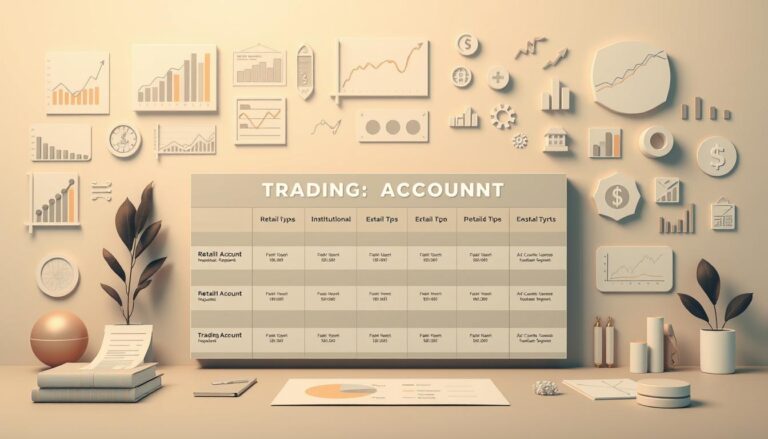Discover What is CFD Trading? and How it Works
This guide explores a popular method for engaging with financial markets. Contracts for Difference, or CFDs, allow individuals to speculate on price movements.
Traders do not need to own the actual assets, like stocks or commodities. They can profit from both rising and falling prices in various markets.
This approach offers significant flexibility and accessibility for participants in Vietnam and globally. It opens doors to a wide range of financial instruments.
Understanding the core mechanics of these contracts is the first step. This knowledge helps manage potential risks and opportunities effectively.
This beginner’s resource aims to build a solid foundation. It encourages a thorough grasp of each concept before any real market activity begins.
Introduction to CFD Trading
Derivative contracts provide a gateway to global financial markets for modern traders. These financial instruments open doors to diverse opportunities across various sectors.
Understanding the Basics
A contract for difference represents an agreement between two parties. It settles the difference between opening and closing prices. Participants speculate on price movements of underlying assets.
These assets include shares, indices, commodities, and cryptocurrencies. The key advantage lies in not owning the actual asset. Traders gain exposure to price changes only.
This approach differs significantly from traditional investment methods. It focuses purely on price speculation rather than long-term ownership.
Why Traders Use CFDs
Market participants choose these instruments for several compelling reasons. They offer access to diverse financial markets through one platform.
Key benefits include:
- Ability to profit from both rising and falling markets
- Portfolio diversification across multiple asset classes
- Hedging capabilities for existing positions
- Capital efficiency with lower initial requirements
This flexibility makes contract-based trading attractive for various strategies. It serves both speculative and protective purposes in portfolio management.
what is cfd trading?

The concept of speculating on price movements without asset ownership defines contract-based trading. These financial instruments derive value from underlying assets like indices and commodities.
A contract for difference represents an agreement between participants and their broker. They exchange the value difference from when positions open until closure.
The “difference” in these contracts specifically refers to price movements. Profit or loss depends entirely on this price gap calculation.
This approach enables participants to profit from both rising and falling markets. Going long captures upward trends, while short positions benefit from declines.
These instruments operate on margin, similar to forex markets. Leverage allows opening positions exceeding initial capital amounts.
Understanding this foundational concept prepares traders for more complex strategies. It establishes the essential framework for market participation.
CFD Trading Essentials and Key Concepts

The foundation of effective market speculation lies in comprehending key financial relationships. Understanding these core elements helps participants navigate various opportunities with greater confidence.
These instruments operate on fundamental principles that distinguish them from traditional investment approaches. Grasping these distinctions is crucial for informed decision-making.
Contract for Difference Explained
Each contract represents an agreement between the participant and their broker. This arrangement focuses on exchanging the price difference from opening to closing.
The value of the position depends entirely on this price movement calculation. Participants never take ownership of the actual financial instrument involved.
The Role of Underlying Assets
Various assets serve as the foundation for contract pricing. Stocks, commodities, and currencies all provide the basis for these agreements.
Price dynamics of the underlying asset directly influence contract value. This relationship creates the mechanism for market speculation across diverse instruments.
Participants select specific assets based on their market outlook and strategy. This approach offers access to multiple markets through a single platform.
Mechanics of CFD Trading: How It Works

Practical market engagement requires understanding how positions are opened and managed in real-time. This section explains the step-by-step process of executing trades and monitoring results.
Executing Buy and Sell Orders
Market participants begin by predicting future price movements. If they anticipate an increase, they place a buy order to open a long position. When expecting a decline, they execute a sell order for a short position.
The trading platform’s deal ticket provides clear options for both actions. Selecting “buy” establishes a long cfd position, while “sell” initiates a short trade. This decision forms the foundation of every market engagement.
Tracking Price Movements
After opening a position, traders carefully monitor the asset’s price fluctuations. Profit occurs when the market moves in the predicted direction. For long positions, this means prices rising above the entry point.
Short positions generate profit when prices fall below the initial level. The final calculation involves the difference between opening and closing prices. This amount determines the actual profit or loss after accounting for costs.
Both long and short trades carry potential risk. Market movements against the prediction can result in financial loss regardless of position type.
Benefits and Flexibility of Trading CFDs

The appeal of contract-based market participation stems from several distinct advantages. These instruments offer unique features that attract modern traders seeking efficient market access.
Participants benefit from operational flexibility and capital efficiency. These advantages make market engagement accessible to various types of traders.
Leveraged Exposure
Leverage allows controlling larger positions with smaller capital outlays. Traders deposit a percentage of the total trade value as margin.
For example, opening a position on 50 Tesla shares at $800 each creates a $40,000 exposure. With 20% margin requirement, only $8,000 capital is needed upfront.
Margin rates vary across different markets. Popular indices may require just 5%, while individual shares often need 20%.
This leverage magnifies both potential profits and losses. Gains and losses calculate on the full position value.
Extended Trading Hours
Many CFD instruments trade outside traditional market sessions. This provides flexibility for participants in different time zones.
Traders can respond to global market developments as they occur. Extended hours create more opportunities for market engagement.
The combination of leverage, flexibility, and extended access makes this approach attractive. However, these benefits require careful risk management strategies.
Risks and Risk Management in CFD Trading

Effective market participation requires acknowledging potential financial exposure. Data shows over 61% of retail investors experience financial setbacks with these instruments.
This sobering statistic highlights the importance of comprehensive risk management strategies. Understanding various exposure types helps participants make informed decisions.
Margin and Leverage Concerns
Leverage amplifies both potential gains and losses. Financial exposure calculates on the full position value, not just the margin deposit.
Several specific challenges require attention. Counterparty exposure arises from over-the-counter agreements with brokers. Liquidation occurs when account funds fall below margin requirements.
Market volatility can trigger margin adjustments with short notice. Overnight news may create significant price gaps between sessions.
Implementing Stop-Loss Orders
Stop-loss orders serve as essential risk management tools. They automatically close positions when prices reach predetermined levels.
This disciplined approach helps limit potential financial setbacks. Exiting positions before losses become unmanageable protects trading capital.
Participants should implement comprehensive strategies before opening any market exposure. Financial protection remains the priority for sustainable engagement.
Understanding CFD Trading Costs

Understanding transaction expenses is crucial for calculating potential returns accurately. Market participants face various fees that impact overall profitability.
These expenses include spreads, commissions, and overnight charges. Knowing each component helps traders make informed decisions.
Spreads and Commission Fees
Most instruments incorporate costs within the bid-ask spread. Traders buy slightly above market price and sell below it.
This difference represents the provider’s fee. However, share and ETF contracts typically use a different approach.
For these instruments, prices match the underlying market directly. Instead of spreads, traders pay commission fees when opening and closing positions.
Overnight Funding Charges
Positions held beyond the daily cut-off time incur additional fees. These charges typically apply after 10pm UK time.
Overnight funding covers the cost of maintaining leveraged exposure. The amount varies based on market conditions and position size.
Long positions generally have charges debited from accounts. Short positions may involve interest credits or borrowing costs.
Factoring in all expenses ensures realistic profit expectations. Comprehensive cost awareness supports effective strategy development.
Exploring CFD Trading Platforms and Educational Resources
Choosing the right technological tools can significantly impact a trader’s effectiveness and learning curve. Modern platforms offer comprehensive solutions that combine market access with educational support.
Reputable providers understand that success requires both practical experience and theoretical knowledge. They equip participants with everything needed for confident market engagement.
Browser-Based and Mobile Options
Flexibility defines today’s trading environment. Platforms like MetaTrader 4 provide intuitive interfaces through both desktop browsers and mobile applications.
This dual accessibility allows market participation from anywhere with internet connection. Mobile apps ensure traders never miss important opportunities while on the move.
MetaTrader 5 builds upon this foundation with enhanced features. It offers more timeframes and expanded analytical tools for sophisticated strategies.
The demo account serves as an essential starting point for all experience levels. It provides virtual funds for practice in realistic market conditions.
Key educational resources include:
- Free trading courses covering basic to advanced concepts
- Interactive webinars with market experts
- Strategy articles and real-time market analysis
- Risk-free environment for skill development
Continuous learning separates successful participants from others. Comprehensive education builds the knowledge foundation necessary for sustainable results.
The Role of Underlying Assets and Price Dynamics
Successful speculation depends heavily on understanding the various markets available for engagement through derivative instruments. Each position derives its value from the performance of specific financial components.
Major providers offer access to over 18,000 different markets through a single account. This extensive selection allows for significant portfolio diversification across multiple sectors.
Indices, Commodities, and Forex Markets
Stock market indices represent baskets of leading companies from specific regions or sectors. Participants can speculate on the collective performance of groups like the S&P 500 or FTSE 100.
Commodity markets involve raw materials and natural resources. Gold, oil, and agricultural products each respond to unique supply and demand factors.
Forex represents the world’s largest financial market with daily currency pair movements. Instruments like EUR/USD and GBP/JPY react to interest rates and geopolitical developments.
Each underlying asset category follows distinct price patterns. Understanding these dynamics helps traders identify promising opportunities across different market conditions.
Strategic Approaches for Successful CFD Trading
Consistent results in financial markets require systematic approaches and careful preparation. A well-structured methodology helps participants navigate various conditions with confidence.
Developing a Trading Plan
Every successful market participant begins with a clear investment strategy. This document outlines specific goals and risk tolerance levels.
The plan should define entry and exit criteria for each trade. It must include position sizing rules and loss limits. Thorough market analysis precedes any market activity.
Participants choose between aggressive or conservative approaches. Both require disciplined execution and emotional control.
Utilizing Demo Accounts for Practice
Providers offer free demo account options with virtual funds. This environment allows risk-free testing of various strategies.
Traders can practice opening and closing position types without financial pressure. The transition to live trading occurs only after consistent success.
This preparation phase builds essential skills and confidence. It forms the foundation for sustainable market participation.
Regulatory and Market Considerations in CFD Trading
Legal frameworks governing financial markets differ significantly across international borders. Participants must understand these variations before engaging in any market activity.
Rules can change rapidly as authorities respond to new economic conditions. Staying informed is a critical part of a trader’s responsibility.
Country-Specific Guidelines
Some nations have implemented strict prohibitions on these instruments. The United States bans retail participation through SEC regulations.
Hong Kong’s SFC restricts access due to the high risk profile. Belgium also prohibits these OTC agreements for retail investors.
Many other markets permit this activity with proper broker oversight. The global landscape is a complex patchwork of different rules.
Regulations evolve constantly. New restrictions may appear as market conditions shift.
Non-residents might access international platforms, but this requires careful legal review. Verifying the current status in your specific jurisdiction is essential.
Consulting a financial advisor ensures full compliance. Ignorance of local laws does not offer protection from consequences.
Comparing CFDs with Other Trading Instruments
Market participants often evaluate multiple trading approaches before selecting their preferred method. Understanding how different financial instruments compare helps traders make informed choices.
This analysis examines key differences between contract-based trading and other popular market tools. Each approach serves distinct purposes in a trader’s portfolio.
CFDs vs. Futures
Both instruments allow speculation on future price movements. However, their structures differ significantly.
Futures contracts specify fixed dates and prices for transactions. They require exchange trading and may involve physical asset ownership at expiration.
Contract for difference arrangements offer more flexibility without expiration dates. These instruments provide cash settlement without ownership transfer.
Traders can speculate on futures prices through CFDs without purchasing actual contracts. This simplifies access to complex markets.
CFDs vs. Traditional Stocks
Traditional stock ownership involves actual share possession with voting rights and dividends. Investors must consider custody and administrative aspects.
Contract-based trading focuses purely on price exposure without ownership concerns. This approach enables short positions without share borrowing.
Leveraged exposure requires lower capital compared to direct share purchases. The derivative structure eliminates storage and administration requirements.
These differences make CFDs suitable for short-term speculation. Traditional shares better serve long-term investors seeking ownership benefits.
Final Insights for Informed CFD Trading Decisions
The journey into contract-based market speculation culminates with essential principles for sustainable engagement. This comprehensive guide has outlined the mechanics and considerations for responsible participation.
Successful outcomes depend on thorough preparation and disciplined execution. Market participants must carefully manage their exposure and understand how leverage affects both potential gains and losses.
Starting with demo accounts provides valuable practice without financial pressure. This approach builds confidence before committing real capital to market positions.
Continuous learning and adherence to well-defined strategies separate successful participants from others. The flexibility of these financial instruments offers significant opportunities when used responsibly.






